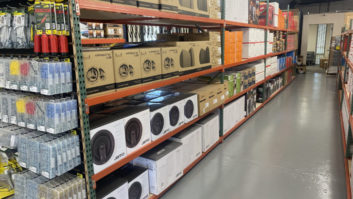LOS ANGELES — CE industry e-commerce strategies, which included an e-tailing primer from keynote speaker Jerry Storch of Target Corp., were offered at the Consumer Electronics Association (CEA) Business Solutions Series 2000 meeting here.
The seminar dealt with e-tailing and much more, such as the Web’s role in handling product returns, using it for merchandising, consumer and retailer education, selling excess inventory and making sites more “sticky” for consumers and business partners.
Storch, Target’s president of financial services and new businesses, outlined to an audience of mostly manufacturers how the mass merchant’s e-commerce plan is all-encompassing.
For Target e-commerce is not just e-tailing, the executive said. “The Internet is very important, so important that we must drive it to become an integral part of our business.”
Storch stressed that the Web is part of Target’s long-term strategy and “serves many purposes aside from consumer sales.” His point is that Target has “a multidimensional growth strategy,” which he described as “brick & mortar on steroids. Target must be developed on brand, not just e-commerce.”
It is Storch’s contention that “key players in e-commerce will be major brands that can play a multi-dimensional strategy.” He noted that only “large companies that can compete on all levels will be successful” in e-commerce and e-tailing.
Based on that philosophy, he answered a question from the audience on CE manufacturers selling direct to consumers with this response: “That is a big issue for us. We would become a showroom for a manufacturers’ sites. I think it is terribly wrong for [vendors] to sell direct to consumers. That is a poor business partner.”
Storch added, “The best manufacturer partner shows product, explains it and tells consumers where it can be purchased.”
As an aside, Storch noted that his company, even without e-tailing, would be able to grow substantially in the near future. The company operates 921 Target stores and could conceivably double its number of stores in the near future. It will also get major growth from its Super Target stores, which include food stores, during the next decade. His point is that Target has a “click & mortar” strategy. “We will have an Internet component in every department. E-commerce-only operations will not survive. You must be diversified. We have a marketing advantage with our stores,” he said.
Target now has a marketing advantage through the Web, which has enabled it to have “multiple points of contact with our consumers,” such as showing its Sunday newspaper advertising specials on the Web so consumers can plan their trips to the store. In addition, Target uses the Internet for distribution functions, employee recruitment and customer service.
Target is also part of the WorldWide Retail Exchange, a business-to-business site that includes Best Buy, JC Penney, Kmart, Safeway and Walgreen’s, among 16 international retailers, which enables the members to lower costs by group buying, among other functions. Storch noted, “This type of business-to-business function should reduce prices for consumers.”
Storch noted that Target has tried to make a profit on the Web. In terms of e-tailing, “We don’t sell below cost, we charge shipping and handling and charge the same price as stores. We are probably making a profit at this time because we are saving the company money in other operations.”
Interestingly enough, Storch said that the ultimate value of a website in today’s marketplace is “a guest [consumer] database.”
(For more on the CEA Business Solutions Series 2000, see the June 12 print issue of TWICE and check TWICE Online.)













